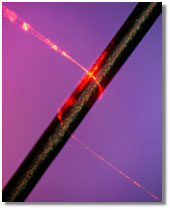 |

|
 |
 |
| A light-conducting silica nanowire wraps
a
beam of light around a strand of human
hair. The nanowires are flexible and can be
as slender as 50 nanometers in width, about
one-thousandth the width of a hair. Credit: Limin Tong/Harvard University |
Researchers Develop Nanoscale Fibers that are Thinner than the Wavelengths of Light they Carry
Researchers have developed a process to create wires only 50
nanometers (billionths of a meter) thick. Made from silica, the same mineral
found in quartz, the wires carry light in an unusual way. Because the wires
are thinner than the wavelengths of light they transport, the material serves
as a guide around which light waves flow. In addition, because the researchers
can fabricate the wires with a uniform diameter and smooth surfaces down to
the atomic level, the light waves remain coherent as they travel. The smaller
fibers will allow devices to transmit more information while using less space.
The new material may have applications in ever-shrinking medical products and
tiny photonics equipment such as nanoscale laser systems, tools for communications
and sensors. Size is of critical importance to sensing—with more, smaller-diameter
fibers packed into the same area, sensors could detect many toxins, for example,
at once and with greater precision and accuracy.
More... (posted
December 19, 2003) |
 |
|
 |
| The cap carbonate contains disrupted and
cemented textures similar to modern methane seeps underneath
the seafloor. Photo by Ganqing Jiang at the University
of California at Riverside. |
Stable Isotope Data Provide Evidence for Huge Global Methane Release about 600 Million Years Ago
The Earth's most severe ice coverings are thought
to have occurred about 600 million years ago, with frozen ice sheets
covering much of the globe. Some scientists have suggested the
oceans froze over during that time, resulting in a white planet
or "snowball Earth" that would have reflected much of
the Sun's heat and resulted in a condition of persistent extreme
cold. Now, in a study published in the December 18 issue of the
journal Nature, scientists describe new evidence from south China
that explains how the planet might have thawed from its icy past.
According to geologist Ganqing Jiang of the University of California
at Riverside and lead author of the paper, the results point to
the release of the powerful "greenhouse gas" methane,
than to the release of carbon dioxide, which has been believed
to be the mechanism by which the Earth re-warmed.
More... (posted
December 19, 2003)
|
 |
|
 |
| The flow chart depicts the process
that
George Daley, Niels Geijsen and their
colleagues followed to derive sperm-like
cells, and eventually culture embryoid
bodies, from embryonic mouse stem cells.
Credit: Niels Geijsen, Massachusetts General
Hospital / National Science Foundation |
|
Researchers Engineer Mouse Embryonic Stem
Cells to Form Sperm Cell Precursors
For the first time, researchers using laboratory
techniques alone and no animal hosts have isolated sex-cell precursors
from mouse embryos, coaxed the cells into a sperm-like form, used
them to fertilize mouse eggs, and ultimately formed early-stage
embryos. The research may offer a breakthrough tool for studies
of embryonic cells and gene delivery, potentially helping scientists
develop treatments for infertility and providing insight into the
growth of certain tumors. The researchers, led by George Daley
of Children's Hospital and the Dana Farber Cancer Institute in
Boston and Niels Geijsen of Massachusetts General Hospital, also
in Boston, report their findings in the December 10, 2003 Nature
(online). Researchers are excited about stem cells because they
can be coaxed into forming a number of tissues, from bone to lung,
while mature cells are limited to their given role.
More... (posted
December 19, 2003) |
 |
|
Detecting Terrorists and Other Hidden Groups on the
Internet
In the free-form clamor of the Internet's
discussion groups and other public forums, Mark Goldberg, Malik
Magdon-Ismail and their colleagues at Rensselaer Polytechnic Institute
want to listen for the whispers of groups trying to stay hidden.
Since September 11, 2001, some have feared that general-interest
Internet forums could be co-opted by terrorist groups to camouflage
coded messages. To detect those groups amidst unrelated Internet
traffic, the RPI team has combined statistical learning algorithms,
graph theory, social network theories and other methods to trace
the patterns of message exchange and study how they evolve. From
the evolving patterns alone—and without the need to read
or understand the messages themselves—they can reverse-engineer
the social networks that form naturally among discussants, as well
as the messages exchanged among the members of groups that had
been concealing their communications.
More...
(posted December 19, 2003) |
 |
| |


|

